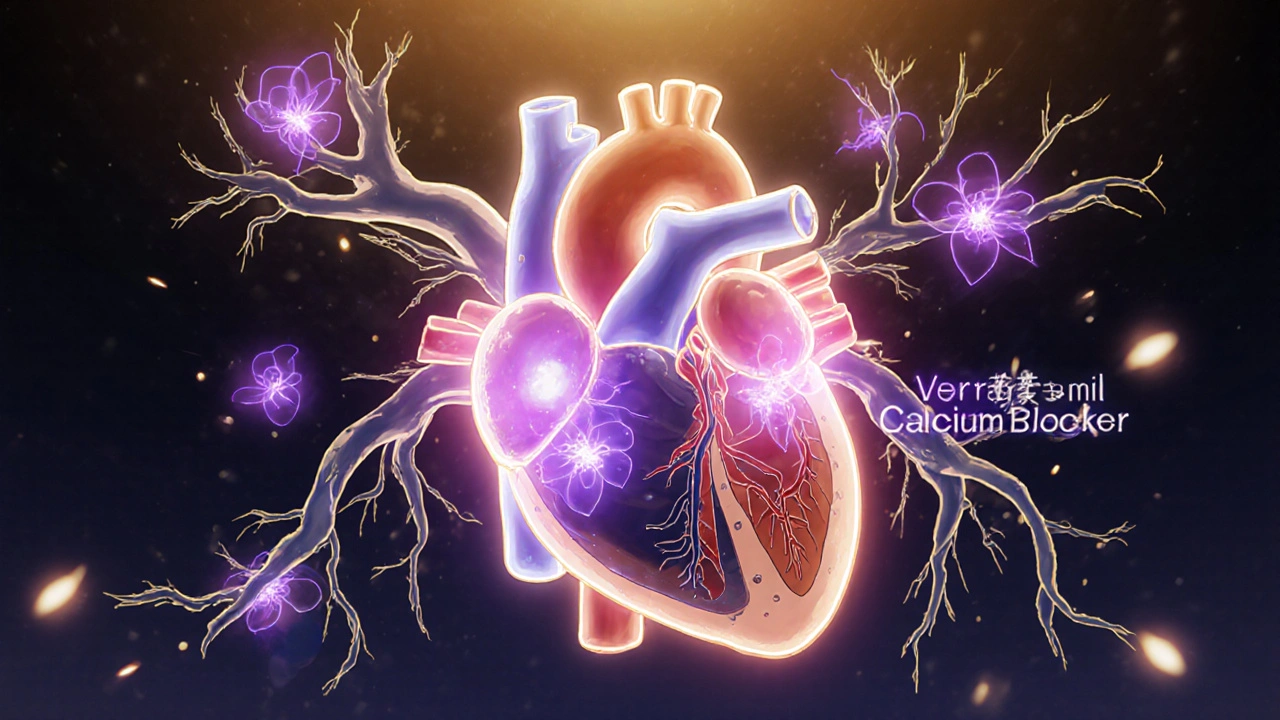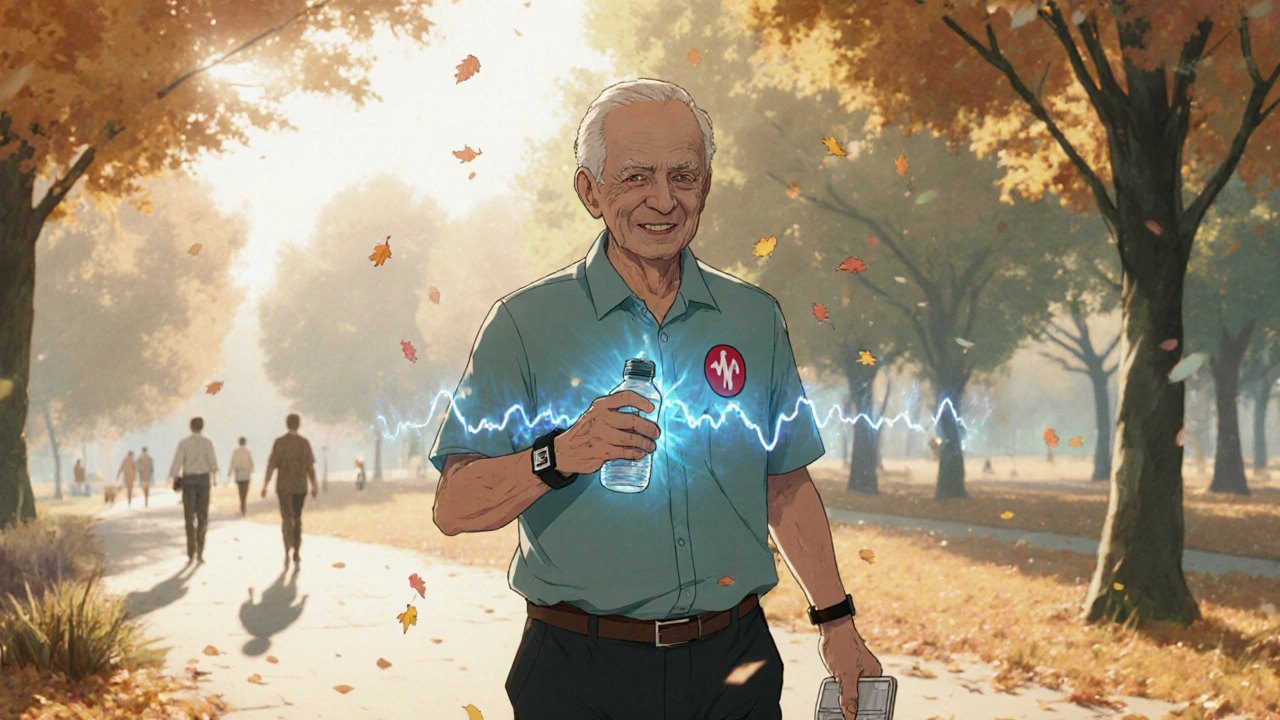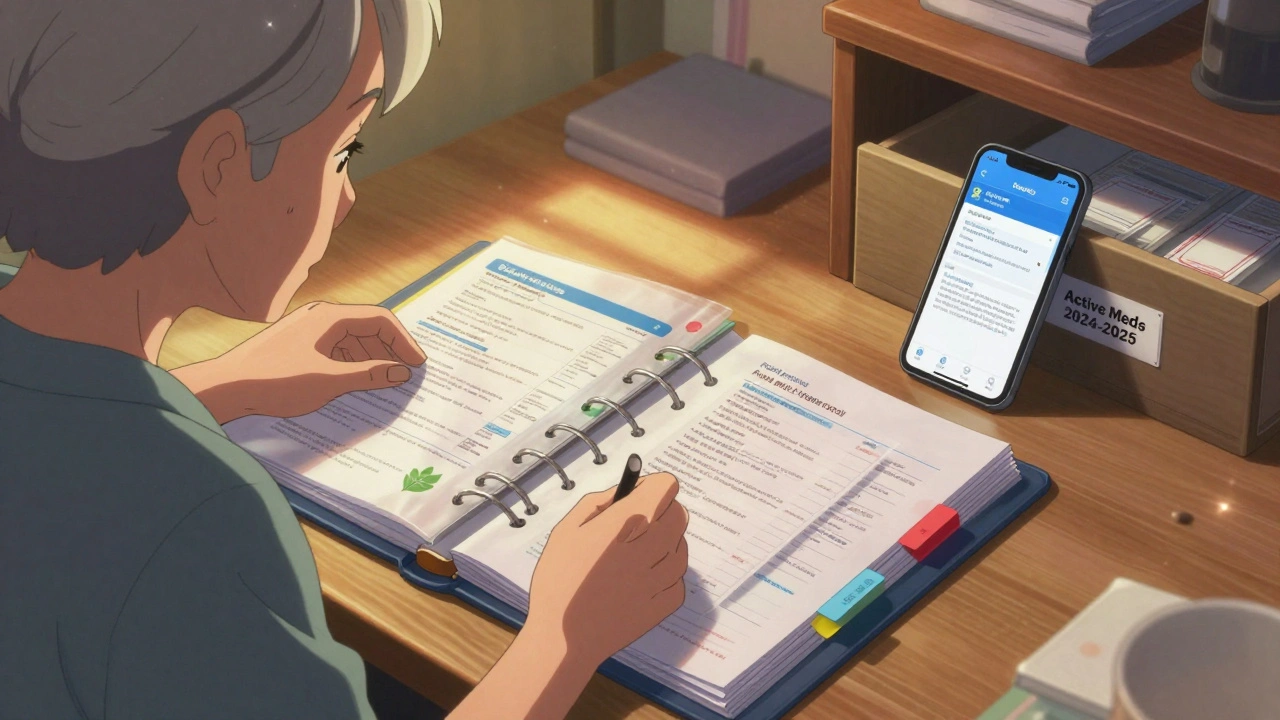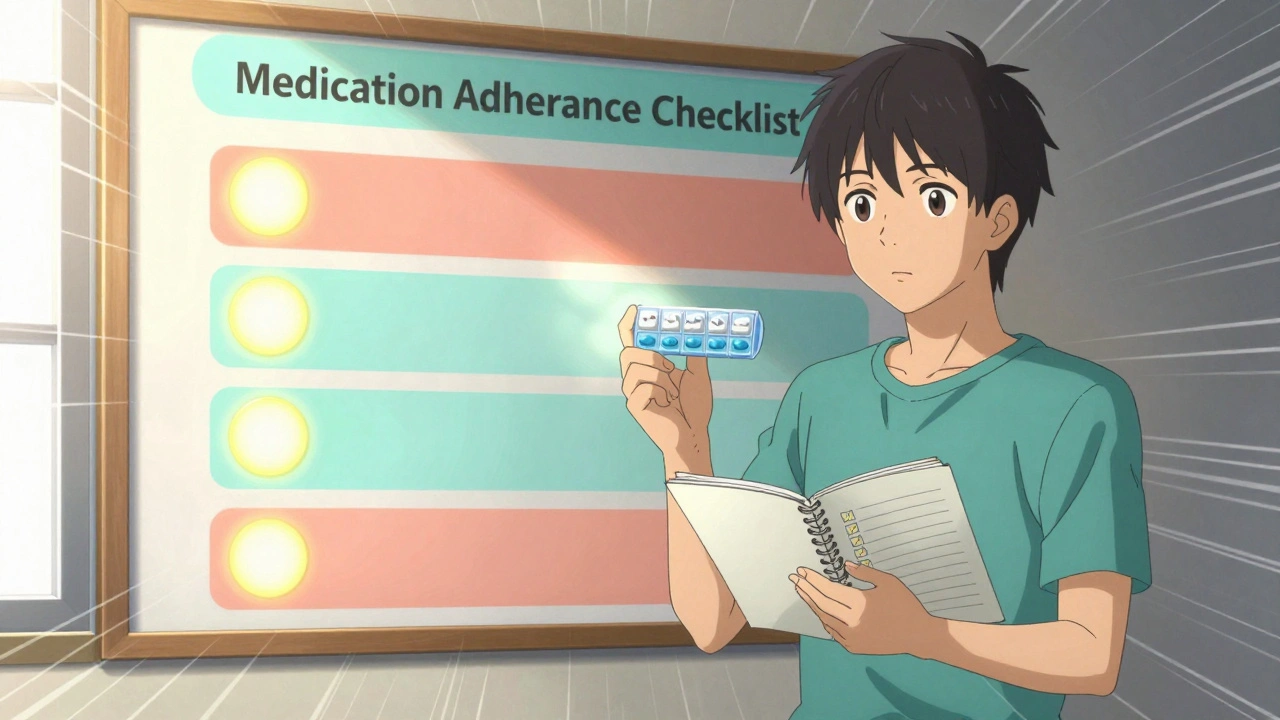Calan: What It Is, How It Works, and When It’s Prescribed

Calan is a brand name for the medication verapamil, a calcium channel blocker used to treat high blood pressure, chest pain (angina), and certain heart rhythm disorders. Unlike some blood pressure meds that make you tired or dizzy, Calan works by relaxing your blood vessels and slowing your heart rate - helping your heart work less hard without knocking you out. It’s been around since the 1970s, but it’s still a go-to for millions of people, especially those who can’t tolerate beta-blockers or need something that doesn’t cause coughing like ACE inhibitors.
How Calan Works in Your Body
Calan blocks calcium from entering the muscle cells in your heart and blood vessel walls. Calcium normally tells those muscles to contract. When it’s blocked, the muscles relax. That means your arteries widen, lowering your blood pressure. At the same time, your heart doesn’t pump as fast or as hard, which reduces the oxygen your heart needs - a big help if you have angina.
This dual effect makes Calan useful for two common problems: high blood pressure and chest pain. It doesn’t just mask symptoms - it changes how your heart and arteries behave over time. People who take it regularly often notice fewer episodes of chest tightness during walks or stairs, and their blood pressure readings drop steadily over weeks, not days.
Who Gets Prescribed Calan?
Doctors reach for Calan in three main situations:
- High blood pressure (hypertension) - especially when other meds like diuretics or ACE inhibitors haven’t worked well, or cause side effects.
- Chronic angina - chest pain caused by reduced blood flow to the heart. Calan helps prevent these episodes by reducing the heart’s workload.
- Heart rhythm problems - particularly supraventricular tachycardia (SVT), where the heart suddenly races. Calan slows down the electrical signals that cause those fast beats.
It’s often chosen for older adults or people with asthma or diabetes because it doesn’t worsen breathing like beta-blockers can, and it doesn’t spike blood sugar like some diuretics. A 2023 study in the Journal of the American Heart Association found that patients over 65 with both hypertension and atrial fibrillation had better rhythm control on verapamil than on other calcium blockers.
Dosage and How to Take It
Calan comes in two forms: immediate-release tablets and extended-release capsules (Calan SR). The dose depends on what you’re treating and how your body responds.
For high blood pressure, most people start with 80 mg three times a day for the regular version, or 120-240 mg once daily for the extended-release version. For angina or arrhythmias, doses can go up to 360 mg per day in divided doses. The extended-release version is often preferred because it’s taken once or twice a day, making it easier to stick with.
Take it with food to reduce stomach upset. Don’t crush or chew extended-release tablets - they’re designed to release the drug slowly. If you miss a dose, take it as soon as you remember, unless it’s close to your next dose. Never double up.
Common Side Effects and What to Watch For
Most people tolerate Calan well. But side effects can happen:
- Constipation - the most common. Eat more fiber, drink water, and move around.
- Dizziness or lightheadedness - especially when standing up fast. Take your time getting up.
- Swelling in ankles or feet - mild fluid retention. Usually goes away with time.
- Headache or fatigue - often fades after a few weeks.
Call your doctor right away if you notice:
- Very slow heartbeat (under 50 bpm)
- Fainting or near-fainting
- Shortness of breath that’s new or worse
- Unexplained weight gain or swelling in your belly
These could mean your heart is struggling. Calan can worsen heart failure in rare cases, especially if you already have it.

What You Shouldn’t Mix With Calan
Calan interacts with a lot of common meds. Here’s what to avoid:
- Statins like simvastatin or lovastatin - Calan can make their levels spike, raising the risk of muscle damage.
- Beta-blockers - combining them with Calan can slow your heart too much.
- Alcohol - makes dizziness and low blood pressure worse.
- Some antibiotics like clarithromycin or erythromycin - they interfere with how Calan is broken down.
- Grapefruit juice - even a glass a day can raise Calan levels by up to 60%.
Always tell your pharmacist or doctor about every supplement or over-the-counter pill you take. Even something as simple as St. John’s wort can make Calan less effective.
How Calan Compares to Other Heart Meds
Here’s how Calan stacks up against other common heart medications:
| Medication | Primary Use | Side Effects | Drug Interactions | Frequency |
|---|---|---|---|---|
| Calan (verapamil) | High blood pressure, angina, arrhythmias | Constipation, dizziness, swelling | Many - statins, beta-blockers, grapefruit | 1-3 times daily |
| Amlodipine (Norvasc) | High blood pressure, angina | Swelling, flushing, headache | Fewer - mainly grapefruit | Once daily |
| Metoprolol (Lopressor) | High blood pressure, heart rhythm, post-heart attack | Fatigue, cold hands, depression | Many - especially other heart meds | 1-2 times daily |
| Lisinopril (Zestril) | High blood pressure, heart failure | Cough, dizziness, high potassium | NSAIDs, potassium supplements | Once daily |
Calan is more likely than amlodipine to cause constipation but less likely to cause swelling. It’s more effective than metoprolol for certain arrhythmias but doesn’t help after a heart attack like metoprolol does. Lisinopril is great for blood pressure and kidney protection in diabetics, but its cough side effect turns many people off.
What to Expect When Starting Calan
When you start taking Calan, don’t expect instant results. Blood pressure usually drops gradually over 1-2 weeks. Angina symptoms may improve in a few days, but full heart rhythm control can take weeks. Your doctor will likely check your pulse and blood pressure at your first follow-up - usually within 2-4 weeks.
Keep a log of your symptoms: when you feel dizzy, how often your chest tightens, if you’re constipated. This helps your doctor adjust your dose. Many people stop taking Calan because they think it’s not working - but it often takes time. Don’t quit unless your doctor tells you to.
Long-Term Use and Monitoring
Calan is safe for long-term use. Studies show people take it for 10+ years without major issues if monitored. Your doctor will check your liver and kidney function once a year, and may do an ECG every 6-12 months to watch your heart rhythm.
It’s not addictive, and you don’t build tolerance to it. But stopping suddenly can cause rebound high blood pressure or chest pain. Always taper off under medical supervision.
People on long-term Calan should also get regular bone density scans. Some research suggests calcium channel blockers might slightly reduce bone loss over time - a small bonus for older adults.

When Calan Isn’t Right for You
Calan isn’t safe for everyone. Avoid it if you have:
- Severe heart failure (especially with low blood pressure)
- Second- or third-degree heart block (without a pacemaker)
- Very slow heart rate (bradycardia)
- Low blood pressure that’s already too low
- Allergy to verapamil or similar drugs
If you have liver disease, your doctor may lower your dose. Calan is processed by the liver, and impaired function can cause buildup.
It’s generally safe during pregnancy if needed - but only under close supervision. It passes into breast milk, but in small amounts. Talk to your OB-GYN if you’re pregnant or nursing.
Alternatives to Calan
If Calan doesn’t work for you or causes too many side effects, here are common alternatives:
- Amlodipine - better for swelling and easier dosing, but less effective for arrhythmias.
- Diltiazem (Cardizem) - another calcium blocker, similar to Calan but with fewer constipation issues.
- Metoprolol - good for heart rate control, but not for asthma or diabetes.
- Lisinopril - great for blood pressure and kidney protection, but causes cough.
Some people switch to diltiazem if constipation from Calan is unbearable. Others try amlodipine if dizziness is the main problem. There’s no one-size-fits-all - it’s about matching the drug to your body and lifestyle.
Real-Life Tips for Taking Calan
Here’s what works for people who’ve been on Calan for years:
- Keep a water bottle by your bed - drink a glass before getting up to avoid dizziness.
- Take a daily walk - movement helps with constipation and blood pressure.
- Use a pill organizer - Calan often requires multiple doses a day.
- Set phone reminders - missing doses can cause blood pressure spikes.
- Don’t drink grapefruit juice - even one glass can mess with your dose.
- Wear a medical alert bracelet - if you have a heart rhythm issue, it matters.
One patient in Bristol, 72, told me he started taking Calan after a mild heart episode. He swapped his morning orange juice for water, started walking 30 minutes a day, and now his blood pressure is normal. "It’s not magic," he said. "But it lets me live without chest pain. That’s worth a little constipation."
Is Calan the same as verapamil?
Yes. Calan is the brand name for verapamil. Generic verapamil works the same way and costs less. Most people switch to generic once their doctor approves it.
Can Calan cause weight gain?
Calan doesn’t directly cause weight gain, but it can lead to fluid retention, which may show up as swelling in the ankles or a slight increase on the scale. If you gain more than 2-3 pounds in a week, tell your doctor.
How long does it take for Calan to start working?
For chest pain, you might feel better in a few days. For blood pressure, it usually takes 1-2 weeks to see a full effect. Heart rhythm control can take up to 4 weeks. Don’t stop if you don’t feel immediate results.
Can I drink alcohol while taking Calan?
Small amounts - like one drink occasionally - are usually okay. But alcohol lowers blood pressure too, so combining it with Calan can make you dizzy or faint. It’s safest to avoid it, especially when you first start.
Does Calan affect kidney function?
Calan doesn’t harm healthy kidneys. In fact, by lowering blood pressure, it can help protect them over time. But if you already have kidney disease, your doctor will monitor you closely and may adjust your dose.
Is there a natural alternative to Calan?
No natural supplement works like Calan. Magnesium and coenzyme Q10 may support heart health, but they don’t lower blood pressure or control rhythms the same way. Don’t replace Calan with herbs or supplements without talking to your doctor.
Next Steps if You’re on Calan
If you’re taking Calan, here’s what to do next:
- Check your prescription - make sure you’re taking the right dose and form (regular vs. SR).
- Review your other meds with your pharmacist - especially statins, antibiotics, or OTC painkillers.
- Start a symptom log - track dizziness, chest pain, constipation, and pulse rate.
- Book a follow-up in 4 weeks - your doctor needs to see how you’re responding.
- Ask about switching to generic verapamil - it’s often 80% cheaper and just as effective.
Calan isn’t flashy. It doesn’t make headlines. But for millions, it’s the quiet hero that lets them walk, work, and live without chest pain or dizziness. If it’s working for you, stick with it. If it’s not, talk to your doctor - there are other options. But don’t quit without a plan.






Comments
Sameer Tawde
November 18, 2025 AT 11:42Calan saved my dad’s life after his angina got worse. He was on three other meds before this - all made him dizzy or tired. Calan? He just walks the park every morning now. No drama, no fuss. Just works.
Erica Lundy
November 18, 2025 AT 16:36The metaphysical implication of calcium channel blockade as a form of cellular restraint is fascinating - it is not merely pharmacological intervention, but a quiet reordering of physiological autonomy. The heart, in its mechanical surrender to verapamil, becomes a metaphor for the human condition: control through surrender, not domination.
Kevin Jones
November 18, 2025 AT 17:22Verapamil’s L-type calcium antagonism is a masterclass in electrophysiological precision - it selectively targets cardiac and vascular smooth muscle without touching skeletal muscle. That’s why it’s superior to dihydropyridines in arrhythmia control. Amlodipine? It’s just a vasodilator with a side of ankle edema.
Premanka Goswami
November 19, 2025 AT 09:35They say Calan’s safe but they don’t tell you the pharmaceutical giants designed it to keep you dependent. Calcium channel blockers? They’re just a gateway drug to lifelong meds. Meanwhile, the real fix - magnesium, fasting, and grounding - is buried under 17 FDA approvals for brand-name junk.
Alexis Paredes Gallego
November 20, 2025 AT 19:49Calan? Yeah, it’s just another Big Pharma puppet. They make you constipated so you’ll buy laxatives. They make you dizzy so you’ll need a cane. Then they sell you the cane. It’s a pyramid scheme wrapped in a white pill. And don’t even get me started on grapefruit juice - that’s not a warning, it’s a trap.
Saket Sharma
November 22, 2025 AT 07:02Anyone taking Calan without monitoring QT intervals is playing Russian roulette. You think constipation’s bad? Try torsades de pointes. You’re not ‘just tired’ - you’re one ECG away from a code blue. This isn’t wellness, it’s medical negligence dressed in a 1970s lab coat.
Brandon Lowi
November 24, 2025 AT 06:17They call it Calan… but we know the truth - it’s the American Heart Association’s silent handshake with Big Pharma! You think your BP is dropping? Nah. You’re just being slowly pacified by corporate chemistry. Wake up! The real cure is in the soil - in the roots, in the sun, in the sweat you don’t pay for!
mithun mohanta
November 24, 2025 AT 21:40Let’s be real - if you’re on Calan SR, you’re not ‘managing hypertension,’ you’re just participating in the capitalist healthcare theater. The extended-release capsule? A marketing ploy to make you feel like you’re ‘advanced.’ Meanwhile, your kidneys are silently judging you. And yes, grapefruit juice is still forbidden - because the FDA doesn’t trust your willpower.
Ram tech
November 26, 2025 AT 18:25calan? i took it for a week. got constipated and felt like a zombie. switched to amlodipine. no more drama. why do docs even prescibe this? its like giving someone a lollipop then telling them not to lick it.
Jenny Lee
November 28, 2025 AT 11:07My grandma’s been on Calan for 12 years. She still gardens, bakes pies, and argues with the mailman. That’s the real win - not the numbers on the chart. Sometimes the quiet meds are the heroes.
Timothy Uchechukwu
November 29, 2025 AT 09:57Why do Africans have to pay for this American medicine? We have herbs that work better. Calan is just another colonial pill. Your blood pressure is not a problem to be fixed by a white lab coat. It’s a sign you’re out of rhythm with nature
Ancel Fortuin
November 29, 2025 AT 16:50Oh wow, a 2023 study? How convenient. That’s the same year the FDA approved three new statins that cause muscle rot. Calan’s ‘safe’? Sure. Just like asbestos was ‘safe’ in the 50s. They’ll find out in 20 years that it causes silent liver fibrosis - and then they’ll release a ‘new and improved’ version. Classic.
Hannah Blower
November 30, 2025 AT 00:37Let’s be brutally honest - Calan is the pharmaceutical equivalent of a beige sweater: functional, uninspired, and designed for people who can’t handle the side effects of anything interesting. It’s the ‘safe’ choice for doctors who fear liability more than they fear stagnation. And yes, the constipation? That’s not a side effect - it’s a personality test. If you can’t tolerate minor GI distress, you’re not ready for adulthood.
Gregory Gonzalez
December 1, 2025 AT 15:43Oh, so now we’re romanticizing verapamil? How quaint. It’s not a ‘quiet hero’ - it’s a pharmacological compromise. A Band-Aid on a broken valve. The real question isn’t whether it works - it’s why we’ve let medicine become a catalog of tolerable side effects instead of a pursuit of cure.